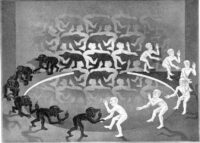Being a grandfather provides the opportunity to experience contemporary fairy-tale movies, and suffice to say, the stories have changed.
The German fairy tales compiled by the Brothers Grimm were indeed quite grim; Sleeping Beauty, for example, included episodes of potential infanticide and cannibalism alongside the more familiar motif of the handsome prince who awakens the beautiful princess with a kiss. Some folklorists associate the disturbing themes of such early oral tales (going back to well before printing) with allegorical renderings about moon calendars vs. sun calendars, the change of seasons and the like.
As these tales worked their way into more contemporary western society, many of the most violent and darkly subconscious aspects were dropped in favor of a more positive and commercial narrative. The original Disney movie of Sleeping Beauty retained the “curse” of sleep placed by a wicked Queen and made the “kiss of pure love” of the handsome Prince the key to the beautiful Princess living “happily ever after.” This sanitized version neatly stripped all aspects deemed “harmful” to young children, reinforcing conventional 20th century cultural messages about jealousy, anger, power, gender, sexuality, and love. Alongside most other popular entertainment, it was the social narrative conveyed to me by the Hollywood of my youth.
America has changed in the past 65 years, and Hollywood along with it. A recent alternate version of Sleeping Beauty named “Maleficent”, alongside the fairy tale genre “Frozen” flip the older narrative upside down. In both these films the “handsome prince” character turns out to be a power-hungry and malicious man of ambition. In both films, the curse-breaking “kiss of pure love” is delivered by the very characters who bear initial responsibility for the curse-induced death-like sleep, and both are women. Thus in one fell swoop within computer-generated scenes of beauty and wonder, conventional roles of gender, the meaning of pure love, power, ambition and social dominance are altered.
An honest appraisal of the male-dominated history of the past 5,000 years must include the admission that for a very long time men have been waging a psychological war on women. Scholars such as Robert Graves and Riane Eisler documented how ancient myths and liturgies were systematically altered to make the role of men positive and the role of women negative. Rules and social customs were changed which stripped women of rights to property and participation in civic society. Inheritance laws were modified from a matrilineal to a patrilineal basis, despite the historical difficulty of proving fatherhood. The list goes on, and the childhood fairy tales of the 19th and 20th Century fully reflected such cultural bias.
Yet here in the 21st Century, as gender-equity and class-related distinctions have gained more attention, our fairy tales are keeping pace. The value of wealth and power as compared with virtue, pureness of the heart as compared with ambition, and the relative insignificance of gender as compared with true love suddenly and convincingly parallel a decidedly well-established, though essentially negative and shallow narrative about human nature and society.
Some may see this trend as subversive, transgressing 5,000 years of accommodated social values, but I find it a refreshingly honest rebalancing of a deeply destructive patriarchal narrative, a persistently materialistic “curse” which pollutes our planet, perpetuates forces of greed and poverty and is hopefully, thank goodness, finally running out of steam.





Be First to Comment